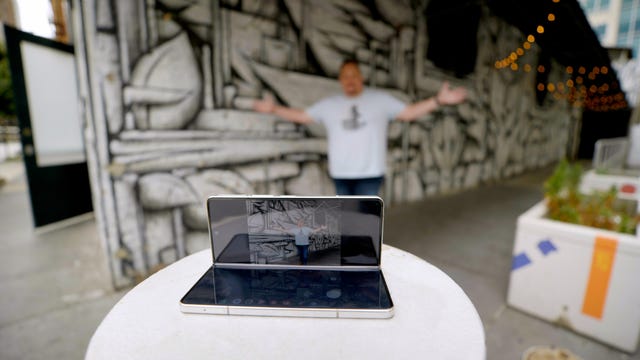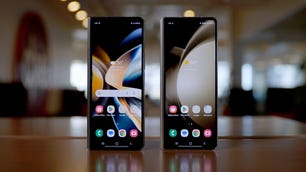Technologies
Will Gen Z Buy Into Flip Phones? Samsung’s Z Flip 5 Aims to Find Out
Persuading teen girls to part with their iPhones is no easy feat. But Samsung’s newest foldable could be the phone to convince them.

Cher Horowitz had one, Serena van der Woodsen had one, Lizzie McGuire had one, and now, in 2023, Sydney Sweeney has one. I’m talking about flip phones, which through the 1990s and early 2000s were the must-have tech status symbol for teen girls everywhere.
I should know, I was one of them. When I rocked up to university, it was with my trusty Motorola Razr — an icon of its time that was famously endorsed by another icon of that time: Paris Hilton.
Just as Motorola tapped Hilton in 2001, Samsung is now leaning heavily on Sweeney, star of the beloved-by-Gen Z HBO show Euphoria and part of the cast of The White Lotus’ first season, to try to convince the teens of today that they need a flip phone in their lives. Specifically, it wants to sell them the Samsung Galaxy Z Flip 5, which it unveiled in Seoul, South Korea, along with the heftier Galaxy Z Fold 5 phone, Galaxy Tab S9 and Galaxy Watch 6 during last week’s Unpacked event.
New and notable features of the Z Flip 5 include a larger cover screen on the front of the phone and a new hinge that allows it to sit fully flat when open and close completely with no gap. It goes on sale Aug. 11, and you can preorder the phone starting at $1,000 (£1,049, AU$1,649). CNET’s Lisa Eadicicco has been using one and says it’s a «step in the right direction» for Samsung.
Sweeney appeared at the event, both in a video and in person with a slicked-back ponytail and short gray dress, taking part in a live demo where she snapped a selfie with K-Pop idol Wonyoung. It’s the cross-cultural brand collaboration of dreams, and a savvy move by Samsung if it wants to appeal to teen girls globally. And it appears that it does.
In its ad for the Z Flip 5, Sweeney says the phone is a «game-changer» for when she’s filming videos on her own and talks about how her favorite part is the option to personalize it to fit her own style. With retro pastel graphics, the ad is designed to be catnip to young women. But Samsung still has a fight on its hands if it wants to convince this audience that the Z Flip 5 should be their next upgrade.
The fate of flip phones
Sadly for the flip phone, it’s a design that fell out of favor with teen girls (and everyone else) with the rise of the smartphone. For the past 15 years, the ubiquitous slimline slab is the only style of phone that’s been worth having — perhaps until now. Over the past few years, makers of Android phones have been developing their own foldable phones, including new generations of the Razr and the newly introduced Google Pixel Fold, packing flexible displays that can be flipped out to increase the screen size. Still, foldable phones accounted for only 1.2% of phone shipments last year, according to IDC, with Samsung dominating that category.
The majority of these phones are similar in size to a standard smartphone, and double in screen size when unfolded. But the Z Flip is half the size of a standard phone, and expands to the size of most smartphones in fold-out mode, making it ideal for people who like the idea of carrying a smaller device — a teenage girl, perhaps?
The «vintage» clamshell design of the flip phone has the potential to pique the interest of Gen Z users, most of whom are largely loyal iPhone users, according to a Financial Times report from February. There’s also some anecdotal evidence to suggest that some teens are already ditching their smartphones in favor of «dumb» old-school flip phones, according to CNN and other media reports. The Z Flip 5 offers the best of both worlds — the nostalgic look and feel of yesterday’s tech, with the cutting-edge features of today’s.
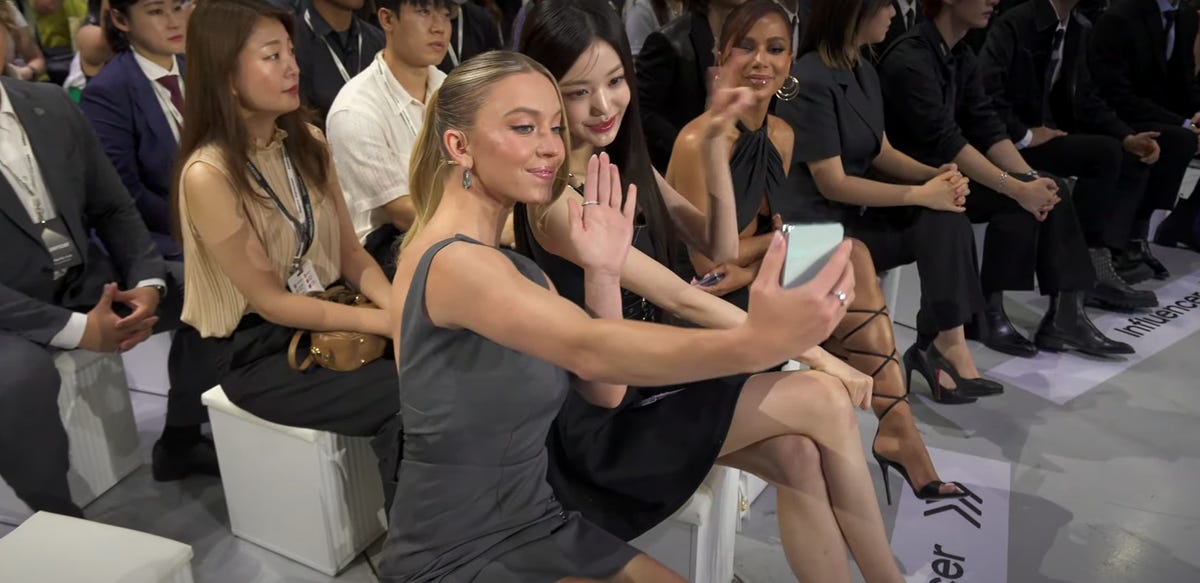
It’s notable, said CCS Insight chief analyst Ben Wood, that Samsung’s marketing and advertising campaigns for the phone heavily feature women and female influencers. (Its other products are all largely promoted by members of male K-Pop band BTS.) Android phone users have historically skewed slightly male, according to CCS research, with manufacturers struggling to attract as many female users. But the Z Flip 5 could provide some real competition to the iPhone in this regard, and the inclusion of Sweeney should «help drive interest in the product,» said Wood.
«Having an attractively designed device that offers a more compact alternative to an iPhone may be more appealing to female customers, and anecdotal feedback so far seems to suggest the Flip form factor does resonate well with women,» he said.
Flippin’ pricey
One potential roadblock for the Z Flip 5 on its way to winning the hearts and minds of teens everywhere is price. Foldable phones have struggled on the whole to gain mainstream traction at least in part due to their $1,000-plus price tags. The Z Flip 5 comes in at just under this, at $999, making it more affordable than most. (For contrast, Samsung’s other foldable phone, the Z Fold 5, starts at $1,800.)
It could be in Samsung’s favor that the improvements it’s made to this year’s Z Flip offer better value for money, said Anisha Bhatia, senior analyst at GlobalData.
«Samsung is following its Galaxy S23 strategy by giving consumers ‘more’ for the same price in this time of inflationary stress,» she said. «The Flip 5 costs the same as its predecessor at $999 but doubles the base storage to 256 GB.»
Make no mistake: That’s still a hefty amount to part with whether you’re a young person or a parent of one. But no high-end phone these days comes cheap, and the Z Flip 5 offers a lot for the money, while standing out in a crowded market with its unique design.
If any phone can tempt Euphoria and K-Pop fans to embrace Android and foldable screen technology, it wouldn’t be surprising if the Z Flip 5 is the one to do it.
Technologies
Today’s NYT Mini Crossword Answers for Friday, Jan. 9
Here are the answers for The New York Times Mini Crossword for Jan. 9.
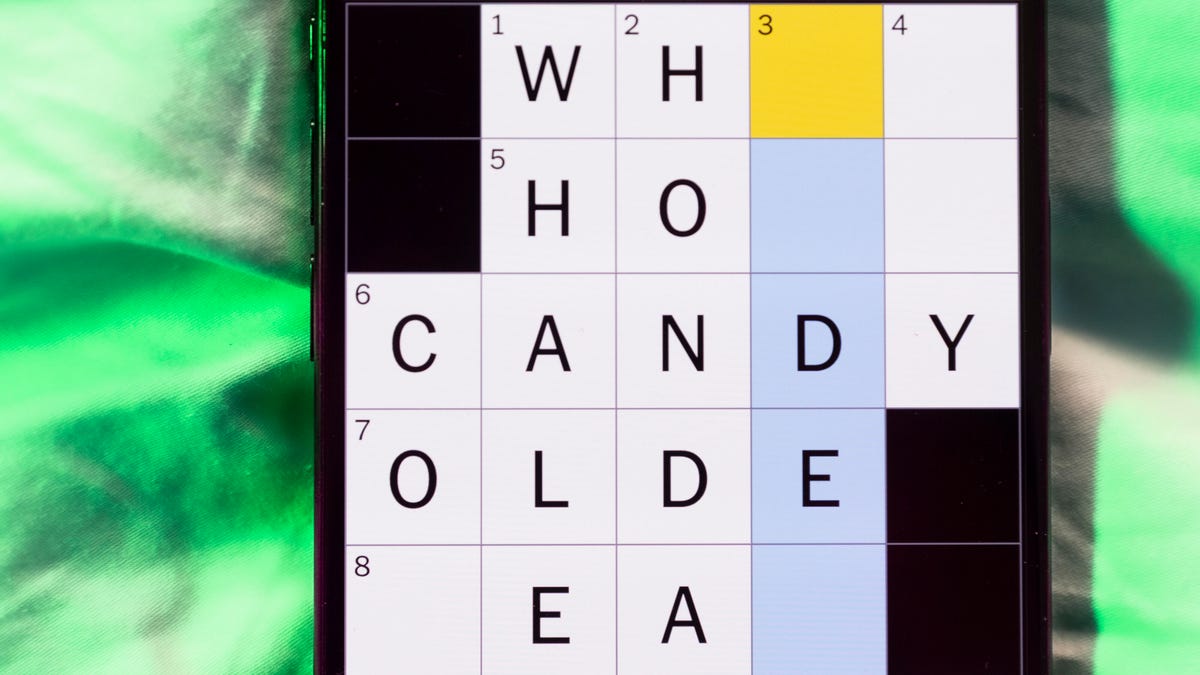
Looking for the most recent Mini Crossword answer? Click here for today’s Mini Crossword hints, as well as our daily answers and hints for The New York Times Wordle, Strands, Connections and Connections: Sports Edition puzzles.
Need some help with today’s Mini Crossword? The Across clues were kind of tough today. Read on for all the answers. And if you could use some hints and guidance for daily solving, check out our Mini Crossword tips.
If you’re looking for today’s Wordle, Connections, Connections: Sports Edition and Strands answers, you can visit CNET’s NYT puzzle hints page.
Read more: Tips and Tricks for Solving The New York Times Mini Crossword
Let’s get to those Mini Crossword clues and answers.
Mini across clues and answers
1A clue: Question in a late-night text
Answer: YOUUP
6A clue: Plentiful
Answer: AMPLE
7A clue: Saint ___ and Nevis (Caribbean nation)
Answer: KITTS
8A clue: Baby-bringing bird
Answer: STORK
9A clue: Take care of the tab
Answer: PAY
Mini down clues and answers
1D clue: Himalayan herbivores
Answer: YAKS
2D clue: Fail to include
Answer: OMIT
3D clue: «High five!»
Answer: UPTOP
4D clue: The «U» of UV rays
Answer: ULTRA
5D clue: Annoying to deal with
Answer: PESKY
Don’t miss any of our unbiased tech content and lab-based reviews. Add CNET as a preferred Google source.
Technologies
I Got Up Close and Personal With Boston Dynamics’ New Atlas Robot
Before Atlas takes its first steps into the world of work later this year, I found myself face-to-face with CES 2026’s most talked-about robot on the show floor.
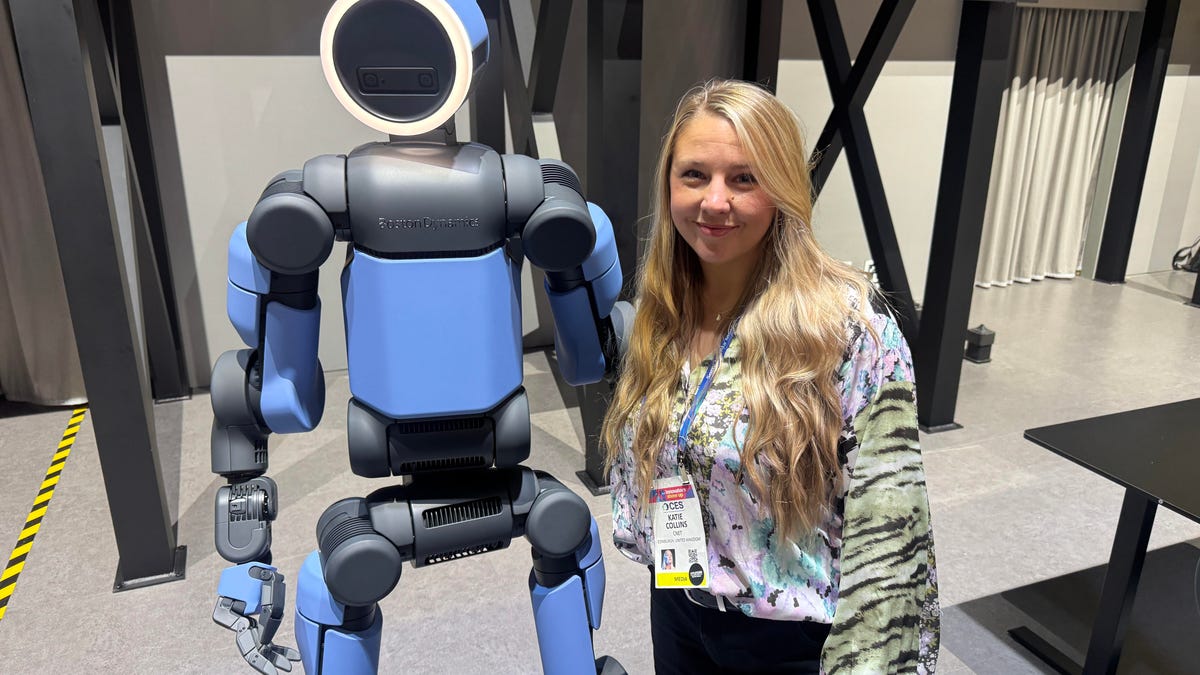
When I say that I went hands-on with the new Boston Dynamics Atlas robot, I mean that I actually held hands with it. This humanoid robot, which CNET just awarded the Best Robot of CES Award, is one of the most advanced in the world, and I couldn’t pass up the opportunity to get up close and personal with it.
This product version of the robot, which is set to be shipped to Hyundai factories imminently to start working, has been the talk of CES this year. The specific Atlas robot I encountered was a static model that wasn’t turned on or fully operational. Our interactions were, therefore, sadly one-sided. Still, I ran my hands over its soft-touch plastic shell and gently prodded at its finger joints, wondering how it would feel if they gripped me back.
People tend to have varying feelings about humanoid robots — understandable given that they are built to some degree in our image, while also usually being stronger than us, with «brains» that we don’t fully understand. Atlas definitely evokes contradictory emotions for me — even more so when I stood face-to-face with it.
I’m in awe of the engineering, a little fearful of its capabilities, hesitant about what it could mean for the future of humanity and charmed by its design and styling. The periwinkle blue iteration of Atlas that I met on the show floor at CES 2026 almost bears more resemblance to a Dyson product than it does the industrial robots that defined Boston Dynamics’ early days, when it was best known for its work with DARPA.
«There’s a lot of really specific things about this robot that probably look a little weird,» said Zachary Jackowski, Boston Dynamics VP and general manager of Atlas. He pointed to the legs, which he described as «like nothing anyone else was doing.»
Atlas’ thighs are narrow set and in line with the torso, while the calves are wider set, attached to their upper counterparts with a circular joint. This robot is, in fact, all subtle curves and soft lines. There are no harsh edges or stark angles.
During a year when CES has been flooded with humanoid robots, Atlas definitely does stand out due to its design. It appears both less classically human and less industrial than some of its peers, while also lacking the often intimidating, featureless faces they tend to exhibit. Instead, it has two low-set cameras resembling eyes placed where you’d usually expect a mouth to be. Its face is a perfect flat circle, defined by an LED halo that gives it a somewhat Pixar lamp effect.
I asked Jackowski why Boston Dynamics decided to skew so relatively unhuman with this version of its humanoid. «Well, it’s not a human,» he said. «It projects the wrong first impression about a robot to have it pretend to be something that it’s not.»
Particularly in the early days of humanoids, he added, robots won’t have anything like human-like intelligence. People should look at it and see it for what it is — a tool for performing tasks safely and efficiently.
In fact, most of the design decisions were made to keep Atlas as simple, scalable and safe as possible, Jackowski said. I remark that there’s some irony in thinking of a humanoid robot as simple, given the complexity of the technology and development process to bring Atlas to life.
The key to making it simple, Jackowski said, is having a strong enough grasp of the technology to «accomplish the complex thing of building a humanoid robot,» but then being able to take it apart and understand that you can use fewer computers and actuators in it while achieving the same results.
And it’s essential to Boston Dynamics that Atlas is perceived as simple. After all, it’s a general-purpose humanoid, which might eventually be sent far and wide to fulfil all manner of roles. Jackowski calls it the «ultimate generalist.»
Simplicity aside, there are aspects of Atlas that Jackowski believes set it apart from other humanoids at the show. «The repairability of this robot is crazy good,» he said. «The runtime is crazy good. The strength is unlike anything.»
From working in Hyundai’s manufacturing plants, Atlas’s job trajectory is to eventually graduate to many of the same industrial environments where Boston Dynamics’ Spot robot works, before moving to bussing tables in the service industry and eventually into the home. The robot will evolve between now and then, Jackowski said. However, this could be an early glimpse of the type of humanoid that will eventually be our housemate.
That’s some way away, though, which is probably for the best. As I gaze up at Atlas, which I’d guess is around the same height as my husband, my feeling is that, however impressive Atlas is, I’m still not ready for it to move in.
Technologies
This Star Wars Dartboard Has a Secret That Will Stop You From Using the Force to Win
This cool dartboard has cameras to track your score and keep you honest
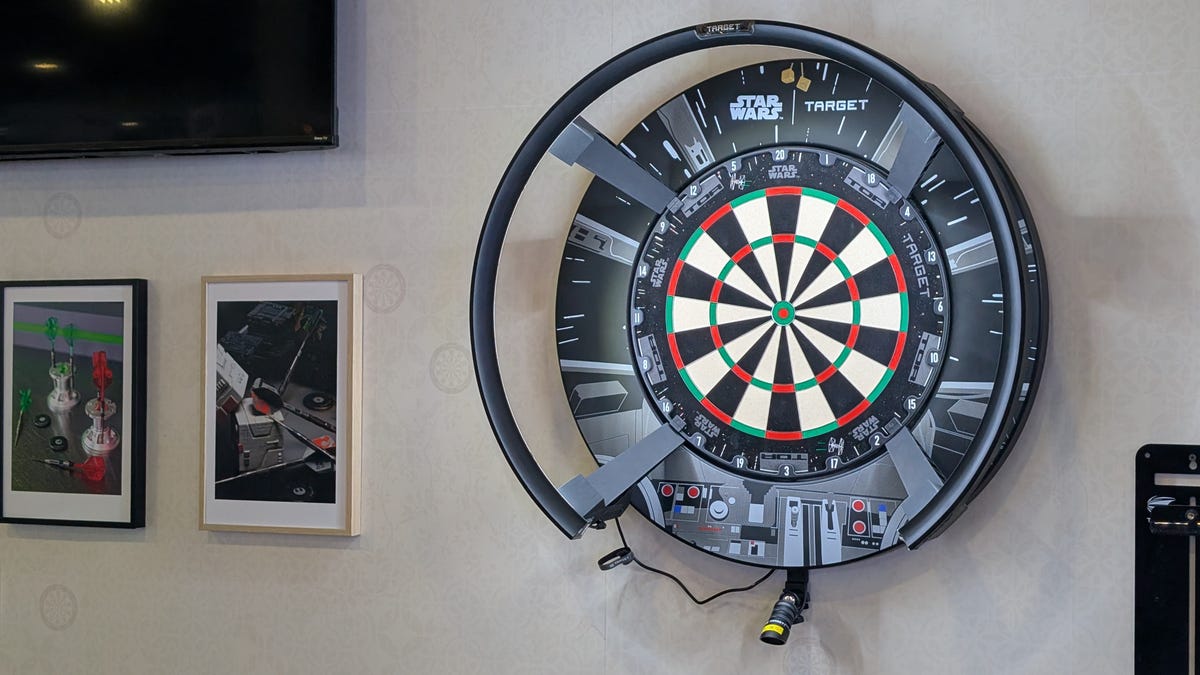
Right in the middle of the high-tech show floor at CES 2026 sits a pub called the Bull and Barrel with some of the coolest dartboards I’ve seen. Target Darts was showcasing its collaboration with both Star Wars and Xbox. Darts may not be for everyone, but I love «shooting some arrows» in my basement with the family. I also love anything Star Wars themed, so these tick a lot of boxes.
The basic Star Wars set comes with a branded board and wall protector that resembles the cockpit of the Millennium Falcon and costs $200. The board is of very high quality, with a tight-knit sisal fiber face, and the protector is thick enough to keep stray shots out of your drywall. The graphics are cool too, with nods to the original Falcon and even have the gold dice hanging above.
The big tech twist to this board, though, is the Omni light ring around the outside. It uses four cameras to track your dart’s position, then sends that info to an app that keeps score. The scoreboard is crisp and clear and uses the voice of legendary darts announcer John McDonald to narrate your game. It’s pretty great to hear his voice announce my terrible scores.
The Omni also allows you to connect with other players worldwide via shared scoreboards. I love the idea of my dad having a board at his house or playing a match with me at my house. It adds a feeling of community to home darts that you don’t normally get outside a pub or bar.
The Omni is a much more expensive proposition than the Star Wars set, coming in at $650, but if you’re serious about the game and a Star Wars fan, it looks to be a great investment.
-

 Technologies3 года ago
Technologies3 года agoTech Companies Need to Be Held Accountable for Security, Experts Say
-

 Technologies3 года ago
Technologies3 года agoBest Handheld Game Console in 2023
-

 Technologies3 года ago
Technologies3 года agoTighten Up Your VR Game With the Best Head Straps for Quest 2
-

 Technologies4 года ago
Technologies4 года agoBlack Friday 2021: The best deals on TVs, headphones, kitchenware, and more
-

 Technologies4 года ago
Technologies4 года agoGoogle to require vaccinations as Silicon Valley rethinks return-to-office policies
-

 Technologies4 года ago
Technologies4 года agoVerum, Wickr and Threema: next generation secured messengers
-

 Technologies4 года ago
Technologies4 года agoOlivia Harlan Dekker for Verum Messenger
-

 Technologies4 года ago
Technologies4 года agoiPhone 13 event: How to watch Apple’s big announcement tomorrow

